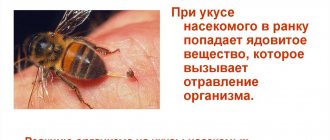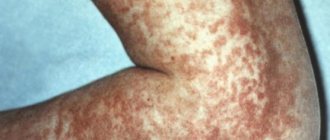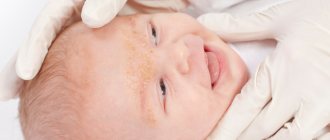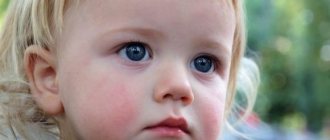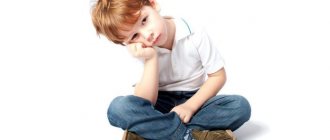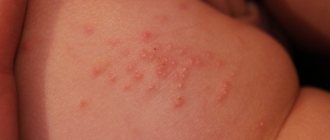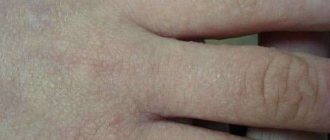The main causes of rashes around the mouth
In children, a rash on the chin and near the mouth is by no means a rare occurrence. Parents of babies under 1 year old encounter this problem much more often. Sometimes the cause of rashes on the face is failure to comply with personal hygiene rules. The baby is actively developing, he puts everything into his mouth, thereby becoming familiar with the world around him.
Sometimes a rash on a child’s chin may indicate disturbances in the functioning of the body. Red dots on the face may appear as a result of an infectious infection. Often, a symptom such as a skin rash appears as a result of an allergic reaction.
Rash on the chin of a baby due to excessive salivation
At such an early age, a baby’s skin is still very delicate; it is just beginning to adapt to the environment. Due to excessive salivation in the nasolabial area, infants often experience irritation (we recommend reading: excessive salivation in infants: causes and treatment). Babies suck pacifiers for a long time, the area around the mouth is constantly moistened with saliva, the skin reacts to the irritant with rashes in the form of red spots with blurred contours.
READ ALSO: Cause of acne on the neck in women
This phenomenon is not pathological, as it is caused by natural causes. In a healthy adult, prolonged exposure of the skin to saliva will also lead to irritation. Babies sometimes develop a rash when their baby teeth erupt.
Allergic reaction
Sometimes a chin rash is a symptom of hives. Pimples on a child’s face may appear due to exposure to cold or prolonged exposure to a hot room (we recommend reading: a newborn has small red pimples on his face). Often, irritation around the mouth appears after a walk under the scorching rays of the sun. Hives can appear on the baby's body due to friction with clothing or the seat belts of a child seat in a car.
If the baby is taking medications, then rashes on the face may be the body’s response to drug therapy. Most often, allergies are caused by antibiotics and hormonal drugs, less often by vitamins and plant extracts.
Some parents may confuse chafing on the skin with symptoms of contact dermatitis. Such irritation on the chin is caused by external factors: allergies can be triggered by washing powders, cosmetics, or clothes made of synthetics or wool.
Manifestation of contact dermatitis on the chin
Often infants develop a rash on the skin after introducing complementary foods. Pimples can be localized not only on the chin, but throughout the body: on the back, stomach, legs and arms. Sometimes some new foods cause enlarged tonsils and adenoids. If a food allergy becomes chronic, then scabs appear on the inflamed areas of the skin.
READ ALSO: Nervous rash on the body, on the face, in a child, on an adult on the body, on the face, photo
Allergens can pass into breast milk. The baby may develop an allergic reaction to a particular product consumed by the nursing mother. The disease can only be detected after laboratory tests.
Rashes due to infectious diseases
A rash is one of the symptoms of some infectious diseases. Depending on the causative agent of the disease, the appearance and intensity of the rash can vary greatly. Pimples on the body can appear due to the following diseases:
- chicken pox;
- measles;
- rubella;
- enterovirus infection.
Other reasons
In the neonatal period, 20-30% of newborns develop small pimples on the skin (neonatal acne) (more details in the article: acne in newborns: photo). Many parents are very concerned about these physiological manifestations, but such a rash is not at all dangerous. As soon as the baby's hormonal levels improve, all skin defects will disappear.
The rash can often be noticed only by tactile contact. Colorless pimples appear on the skin, but the pores are not clogged.
Metabolism in newborns is more intense than in adults, so babies often overheat. Because of this, prickly heat appears on their skin. Such rashes do not need to be treated; parents just need to bathe the child and treat the affected areas with powder.
Causes of the rash
Miliaria most often appears in deep folds
It is fundamentally important to divide the causes of rash into two categories: infectious and non-infectious. The first group requires more urgent measures regarding the treatment of the child, since some diseases pose a threat to life or complications in the long term without adequate treatment. In addition, they are capable of spreading quickly.
A rash on the neck can be a symptom of the following infectious diseases:
- viral: rubella, measles, chickenpox, roseola;
- bacterial: scarlet fever, meningococcal infection, staphylococcal infection.
Non-infectious causes of rash:
- hives;
- prickly heat;
- insect bites;
- dermatological diseases;
- acne of newborns;
- diathesis.
Each disease and condition is characterized by a certain appearance of the elements of the rash, their location and time of appearance. The circumstances of the appearance of the rash, as well as other symptoms, help determine the diagnosis.
Bacterial infections

Meningitis rash spreads throughout the body
The most dangerous disease is meningococcal infection. Most often it goes unnoticed by parents and is accompanied by nasal congestion and a rise in temperature. In rare cases, against the background of symptoms, a specific hemorrhagic rash appears on the body: it resembles hemorrhages in the skin, does not disappear and does not turn pale when pressed. The only element that appears is a reason to call an ambulance, as it indicates the penetration of infection into the blood and a threat to the baby’s life.
Scarlet fever is caused by group A streptococcus. You can become infected from a sick child in kindergarten or school. The onset of the disease is sudden with fever, general weakness and vomiting. A small, thick rash appears against the background of reddened skin, especially on the cheeks, sides, armpits, and less often on the neck. The nasolabial triangle and chin are pale, without rash.
A rash with staphylococcal infection is associated with the penetration of bacteria into the blood. It manifests itself in the form of pustular rashes on the child’s body up to the formation of boils. The situation may be a consequence of decreased immune defense, accompanied by itching, general weakness and tearfulness, indigestion, and enlarged tonsils.
Viral infections

The most common quarantine viral disease that causes a rash in a child throughout the body, including on the neck, is chicken pox. It is caused by the herpes virus type 3. The child's temperature rises, weakness, headaches and muscle pain appear. After one or two days, characteristic rashes appear: areas of redness of two to four millimeters, which first thicken and then turn into blisters with usually clear contents. After opening the bubble, a crust forms. The process takes about two days. Due to the non-simultaneous appearance of elements on the body, all stages can be seen. The disease is accompanied by itching, but scratching is not recommended due to residual skin changes.
Rubella, caused by a virus, is easily tolerated by children. On the first day of the disease, round or oval reddish spots appear. Often a small rash is localized behind the ears and on the child’s neck, on the face, back of the head, then spreads to the chest, abdomen and limbs, excluding the elbow and knee. There will be no elements on the plantar and palmar surfaces.
Vaccination against measles is included in the calendar, and therefore the disease is rare in children. Nevertheless, you need to know the signs of the disease, especially for parents who refused vaccination for personal reasons or received a medical exemption. The onset of the disease is acute: high fever, weakness, conjunctivitis, runny nose. First, a white rash appears on the oral mucosa. A week or earlier, spots or lumps of various sizes appear against the background of the second wave of intoxication. They tend to drain and do not itch. On the first day they are found on the face and neck, then on the torso in front and back, shoulders, and then on the limbs.
Measles is dangerous due to complications from the nervous and coagulation systems, and possible disruption of the functioning of all organs.
Roseola rarely appears as a diagnosis due to the lack of specific symptoms and adequate diagnosis. Caused by herpes virus types six or seven. It begins with an increase in body temperature to high numbers, which persists for several days. A rash appears in the form of spots with a pale rim that do not itch and are located on different parts of the body: legs, buttocks, arms, back, but not on the face. After a few days they go away on their own. The fever disappears with the appearance of rashes.
Non-infectious rash
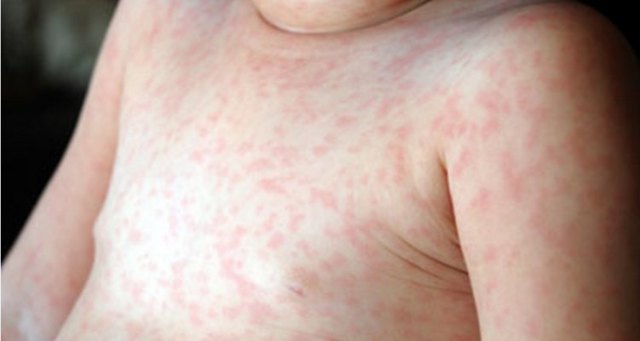
Allergic rash may be caused by medication
Hives are a skin manifestation of an allergic reaction. The cause may be food, medicines, household chemicals, materials, etc. It looks like raised pink or red elements and is accompanied by itching. If swelling occurs, especially in the face and neck, you should immediately consult a doctor.
A common cause of rashes in infants on the neck and other parts of the body is prickly heat. It is associated with overheating of the skin and increased sweating due to excessively warm clothing or bedding. There are three types of the disease: crystalline, deep and red. The first most often affects children under one year old. Elements in the form of small bubbles with white or pearlescent contents, which open and peel off. This type of rash on a child’s neck does not itch. Other types of prickly heat are more typical for adults.
Insects leave behind various elements after a bite. There are few of them, usually these are points, spots or elevations that differ in size, which itch intensely. May increase. As a separate type, scabies can be distinguished - infection by a skin mite that leaves burrows in the spaces between the fingers, soles, palms, scalp, and face. Due to intense itching, scratching can easily become infected, which manifests itself in the form of pustular rashes.
A number of skin dermatological diseases, for example, lichen or psoriasis, are manifested by specific elements on the skin of different parts of the body. They can be flaky, itchy, dry or weeping, and vary in color and size. Usually not accompanied by symptoms from other organs and systems.
Acne of newborns is localized on the face and head, less often on the neck. Looks like small pimples with white caps. It is widespread and most often associated with the influence of maternal hormones from intrauterine development until breastfeeding. It is not dangerous and does not require treatment. Relevant for babies up to about 5 months from birth.
Diathesis is not an independent disease. This is a symptom complex that indicates a predisposition to certain diseases, including in adulthood. Many of the child's systems and organs may be involved. Skin manifestations include a bright, rough rash on the face or other parts of the body.
In what cases does acne on a baby’s face require treatment?
In many cases, irritation on a child’s face appears as a result of physiological reasons, then there is no need to deal with the rash. However, there are diseases that require immediate treatment. You should make an appointment with a doctor if:
- the areas of skin affected by the rash grow;
- drug treatment does not help, the number of rashes does not decrease;
- the inflamed skin began to peel off, and pustules appeared.
READ ALSO: Wen on the back - what the tumor looks like, signs, treatment with folk remedies and surgery
Treatment of the rash
If a child develops a rash, the cause is determined first. Treatment will be aimed at combating the underlying disease. Itching and burning from acne on the face can be relieved with topical medications. In other cases, drug therapy is carried out.
For diaper rash, the baby's skin can be lubricated with Bepanten cream, and for bathing, herbal decoctions (chamomile, string, calendula, etc.) can be added to the bath. Pimples can be wiped with an antiseptic solution.
Food allergies require a special diet. If the baby is breastfed, then the mother should exclude allergenic foods from her diet. The doctor may prescribe antihistamines (Claritin, Zyrtec, Zodac).
For scarlet fever, it is advisable to take a course of antibiotics. If a child has chickenpox, the pimples are smeared with brilliant green and an antipyretic is prescribed (Ibuprofen, Pandol Baby). To quickly get rid of skin defects, children are prescribed vitamin complexes.
In severe conditions, hospitalization is required. Complications can be avoided if you seek medical help in a timely manner and follow doctor’s orders.
Pimples on the face, cheeks or butt in a 4, 5, 6 year old child: causes
Milia
Milia, or water pimples, are tiny white bumps that appear on the face, including the nose, cheeks, or chin, most commonly in children between the ages of 4 and 6. In some cases, milia may also appear on the upper body, as well as also on your baby's arms and legs.
The most distinct difference between baby acne and milia is the color of the bumps. Baby acne is characterized by small red bumps, milia is characterized by tiny white bumps.
Although this child's skin condition can develop at any age, it usually develops during the preschool years of 5 to 6 years. More than 50 percent of all children of different ages have experienced the development of milia in the short term.
Milia is also more common in children born and living in warm climates Milia and pimples on the face and butt are also associated with sweat caused by clothing or fever This skin condition develops in children because tiny pimples are formed as a result of the baby's skin's sebaceous glands not working properly .
Although you may be concerned about the sudden development of pimples or milia in your child, remember that such inflammations usually do not develop for long, being present on the skin for no more than a month and most often disappear within one week. In most cases, milia disappears within a few weeks without any - or treatment Sometimes milia infects a child during the first three months of life.
Ways to quickly get rid of pimples overnight!
Preventing rashes
Preventing acne on the chin is always easier than resorting to long and expensive treatment. To minimize the risk of rashes on the face, you need to follow these rules:
- From an early age, a child must be taught the rules of personal hygiene;
- The baby’s nutrition should be balanced, complementary foods should be introduced gradually and with caution;
- you need to fight constipation so that metabolic processes in the child’s body are not disrupted;
- it is necessary to carry out prevention against worms;
- get vaccinated, adhering to the vaccination schedule.
News MirTesen

